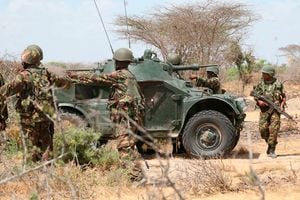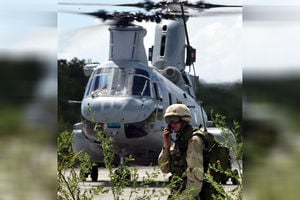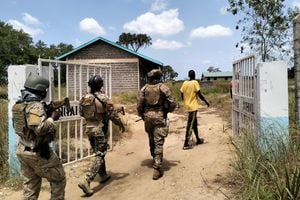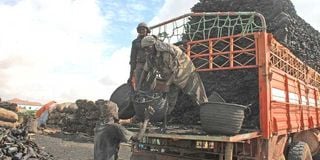
Casual labourers load charcoal on a lorry in an open market in the Yakhshid district of Mogadishu on October 26, 2014. Charcoal is a key source of revenue for al-Shabaab which is known to export charcoal to Gulf countries, earning huge sums.
For years, security agencies have been working behind the scenes to disrupt the money-making machine of Al-Shabaab, a Somalia-based extremist group that presents the biggest regional terror threat. The recent US targeting of individuals and organisations in the funding ecosystem is the latest in the battle.
The group that is known to operate beyond Somalia, including in Kenya, is responsible for indiscriminate acts of violence.
But where does Al-Shabaab get money to buy weapons and equipment and pay its fighters among other operation costs?
The United Nations estimates that this outlawed group makes at least $100 million (approximately Sh13.2 billion) every year.
Most of this money comes from extortion, taxation and illicit trade, including charcoal smuggling and piracy.
However, intervention by the African Union Mission in Somalia – now known as the African Union Transition Mission in Somalia – in an operation spearheaded by the Kenya Defence Forces, saw the capture of Kismayu.
The taking of the port city dealt a severe blow to piracy and the charcoal trade.
While this disrupted and displaced the terrorist group’s funding, it did not stop it.
The UN also says Al-Shabaab has been involved in fundraising abroad, particularly in countries with Somali diaspora.
In July 2022, a meeting of the UN Security Council noted that Al-Shabaab generates millions of dollars from taxing all aspects of the Somali economy “and uses at least 25 per cent of its revenue on military purchases”.
“According to ledgers member states have accessed, Al-Shabaab has approximately $24 million available annually for spending on weapons and explosives,” the council said.
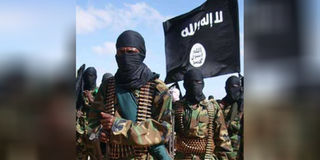
Al-Shabaab militants in Elasha Biyaha, Somalia, on February 13, 2012.
“The ledgers indicate that the group earns $50 million to $100 million every year.”
Details of Al-Shabaab’s money laundering reveal a tale of greed and corruption, of innocence lost and lives destroyed.
In the murky depths of global finance, a clandestine network thrived, unseen by most but felt by many whose bodies stopped bullets fired by mercenaries working for the terrorists.
Just like it did this month, in October 2022, the US Treasury Department exposed a web of deceit, giving the inner workings of Al-Shabaab’s financial machine.
It labelled key figures, each a cog in the engine that fuelled the atrocities.
From the UAE to Eastern Africa, the tendrils of this network reached far, entangling the even the innocent. At the centre of it was Abdullahi Jeeri, a mastermind in weapon smuggling.
He was the architect of al-Shabaab’s artillery, procuring arms from distant lands to fuel the group’s insatiable quest for violence. With every shipment, Jeeri lined the pockets of terror with bloodstained gold.
But he was not alone in this. Jeeri worked closely with Khalif Adale, the architect of the financial web who danced with the devil in the halls of money laundering.
Through sham charities and illicit deals, he channelled millions into al-Shabaab coffers, ensuring their grip tightened on the throat of Somalia.
Another individual listed by the US was Hassan Afgooye, a figure who commanded a complicated labyrinth of financial deceit that saw him weave a tapestry of terror, staining his hand with the blood of innocent people.
The US said from his hideout, Afgooye orchestrated numerous schemes that spanned continents. At the heart of this network is Haleel Commodities LLC, a Dubai-based entity operating under the guise of legitimate business.
Hawala business
However, behind closed doors, it served as a significant financial facilitator for al-Shabaab, funnelling money through its branches and subsidiaries in Somalia, Kenya, Uganda and Cyprus.
Working in tandem with Haleel Commodities LLC was Qemat al-Najah General Trading, an entity based in the United Arab Emirates.
Acting as a node in the money laundering scheme, it manages and transfers funds for al-Shabaab, furthering the terrorist group’s reprehensible agenda.
In Kenya, individuals like Faysal Yusuf Dini and Mohamed Jumale Ali Awale were designated by the US for playing pivotal roles in the network.
Leveraging businesses like Crown Bus Services, they facilitated the transfer of funds on behalf of al-Shabaab, blurring the lines between legitimate enterprise and crime.
The network extended its reach to Finland, where Hassan Abdirahman Mahamed utilised money transfer and hawala businesses to support al-Shabaab’s laundering operations.
Meanwhile, in Uganda, figures like Abdulkadir Omar Abdullahi and Farhan Hussein Hayder managed and transferred funds for the terrorist organisation, further entrenching its influence, the American disclosures show.
Together, these entities and individuals have under the guise of legitimate business, laundered millions of dollars, money that has been used to fund the nefarious attacks by Al-Shabab, resulting in the death and injuries of thousands across the years it has operated.
Armed with weapons so advanced and courage from the skewed truths in their religious teachings by misleading vanguards of their faith, Al-Shabaab militants have woven themselves in the fabric of society.
Also Read:Kenya's new terror hotspots raise alarm
With their grip tightening with every passing day, so feared are they that security bosses in northern Kenya – an area ravaged by the activities of this extremist group – often report that residents dare not speak to them about the whereabouts of the criminals for fear of reprisals.
As the Treasury Department’s designations highlighted, these individuals and entities are instrumental in aiding and abetting al-Shabaab activities.
Whether through direct financial support or facilitating money laundering, they played a crucial role in fuelling the group’s reign of terror across eastern Africa.
Beyond the shadowy world of money laundering and complex operations in the realms of financial trickery, al-Shabaab also extorts people living in areas it occupies in Somalia.
Such a place is the expansive and fertile Juba Valley that slopes all the way from Ethiopia to southern Somalia.
Knowing well that Juba River, which flows through this valley is the country’s breadbasket, the extremists have turned this agricultural hub into their playground.
In 2022, the troops helping restoring peace under the AU told the Weekly Review that militants target farmers and traders in this industrious zone, taxing them illegally.
This is corroborated by the 2023 UN Office on Crime and Drugs report dubbed More Powerful by the Day Terror: Financing and Disruption Efforts in Somalia.
It describes Al-Shaabab as “one of Somalia’s most efficient political organisations”.
The group remains complex, even employing a host of positions, including administrative workers, communication experts, informants, judges, teachers, drivers, porters, mechanics and cooks.
“The group’s finance department employs designated personnel to collect taxes and its intelligence division is said to know “everything that’s going on, enabling it to control ports and see the bills of lading,” the report stated.
Whenever a local dissents, the terrorists forcefully conscript young men into their ranks and take girls for their wives as a warning.
Despite facing military pressure from Somali government forces, Atmis and international partners, al-Shabaab remains a significant security threat in the region.
It continues to control territory in Somalia and carry out attacks, undermining efforts to achieve peace and stability in the Horn of African country.


